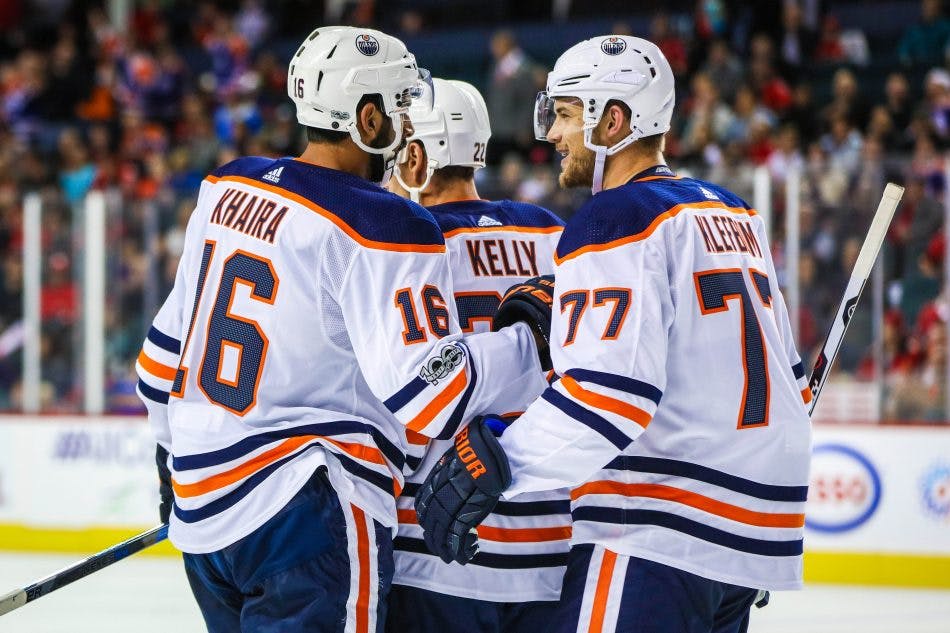There are a lot of reasons the Oilers struggled for so long. Their inability to pull NHL players from later rounds in the draft is certainly one of them.
Back in February, Stephen Burtch wrote about draft pick value for Sportsnet. According to his estimations, the big value lies within the top three picks, then there’s a drop off from three to four, with four-to-15 as the next important range. Later first-round picks have another drop off. “The value of a late first-round pick from a contending team is actually closer in value to any third-round selection than it is to a top-five pick,” Burtch says.
Oct 9, 2017; Edmonton, Alberta, CAN; Edmonton Oilers center Ryan Nugent-Hopkins (93) controls the puck against the Winnipeg Jets during the second period at Rogers Place. Mandatory Credit: Sergei Belski-USA TODAY Sports
The Oilers have been fortunate to pick in the top ten nine times since 2007, including four first-overall picks, but that’s where you’d expect to get a surefire NHL player. It’s the later rounds where Edmonton’s struggled to pull useful players to supplement their top talent.
In the five years prior to 2007, their first top-ten pick in over a decade, they picked and developed Jeff Petry, Kyle Brodziak, Jarret Stoll, and Matt Greene in the second round or later. Those were successful picks. Stoll and Greene were traded for the very effective Lubomir Visnovsky, but Petry and Brodziak weren’t in Edmonton long enough.
2007 on brought similar results. 2009 second-rounder Anton Lander showed flashes of success but couldn’t maintain it. The Oilers had three picks in the second round in 2010. Only Tyler Pitlick is in the NHL, and he has significant injury concerns. The Stars invested three years in Pitlick, which is a pretty big risk.
The Oilers had a very good 2011 draft. They picked Ryan Nugent-Hopkins first overall, Oscar Klefbom 19th, and Tobias Rieder 114th. Nugent-Hopkins might not be a typical first-overall pick, but he’s a good-to-great player. Klefbom’s been playing 22 minutes a night since 2014-15. Rieder is a consistent 30-point guy who can penalty kill, but, for some reason, he was traded as a prospect for Kale Kessy. Edmonton could use a speedy right-wing who penalty kills and scores 15 goals pretty badly. Rieder only makes $2.25 million a season, too.
Dec 2, 2017; Calgary, Alberta, CAN; Edmonton Oilers goalie Laurent Brossoit (1) stops a shot from the Calgary Flames in the first period at Scotiabank Saddledome. Oilers won 7-5. Mandatory Credit: Candice Ward-USA TODAY Sports
This season features both Jujhar Khaira and Brandon Davidson as two of Edmonton’s later-round picks in support roles. Anton Slepyshev is another, although he hasn’t solidified his spot in the Oilers’ lineup.
Khaira’s big, quick and recently on the third line with Leon Draisaitl. The Oilers’ third-round pick in 2012 has nine points in 18 games, including five goals. Khaira makes close to league minimum, so he provides real value if he can score in a support role. He was exposed in the Vegas expansion draft, but the Golden Knights opted for Griffin Reinhart. Reinhart was waived and currently plays for Vegas’ AHL affiliate in Chicago.
Davidson’s previously played a depth role in Edmonton, but was sent out for David Desharnais near the trade deadline last season. Montreal placed him on waivers, and the Oilers have a homegrown talent that can play up and down the lineup again. Davidson doesn’t have big counting stats, but he skates well and moves the puck in the right direction. He’s much quicker than Eric Gryba and less frenetic than Yohann Auvitu.
Caleb Jones and Ethan Bear are recent Oilers draft picks taken in the later rounds that are tracking well. Maybe there’s a player there. Same with Tyler Benson, Ostap Safin, and Kirill Maksimov in the CHL, who were all picked in rounds two or later.
These types of players are essential for contending teams. The Oilers will need them even more when Connor McDavid’s big contract kicks in next year. The salary cap is going up, but a cheap, 20-30 point forward, or third-pairing defenceman who can move up a pairing is always helpful.

